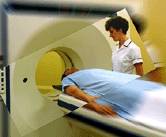
FRIDAY, Sept. 23 (HealthDay News) — Many people who undergo MRI scans describe feeling dizzy while inside the machine or when they come out, and a new study may explain why.
Researchers believe that the strong magnet used during an MRI pushes on fluid circulating in the inner ear, impacting balance and often leading to a feeling of vertigo or free-falling.
In the study, published online Sept. 22 in Current Biology, researchers assigned 10 volunteers with healthy labyrinths (tube-like structures in the inner ears that control balance) and two volunteers who lacked labyrinthine function to undergo MRI scans of different strengths and for various lengths of time.
The investigators asked the volunteers about feelings of vertigo, and monitored the participants’ nystagmus, an involuntary eye movement that happens when the brain is detecting motion.
The study authors found that the healthy people had nystagmus while in the MRI machine, and those without functioning labyrinths did not. As a result, the researchers concluded that this balance center of the inner ear is linked to MRI-induced vertigo.
The study also found that higher MRI strengths caused considerably faster nystagmus among the participants, regardless of how long the scans lasted.
After taking into consideration known facts about the inner ear, the researchers concluded that MRI-related vertigo is probably the result of force exerted on the electrically charged fluid of the inner ear by the magnetic fields of MRIs.
The finding could challenge the results of previous functional MRI studies designed to detect brain activity, the study authors noted, because the scanner itself could be causing brain activity related to movement and balance, skewing results.
“We’ve shown that even when you think there’s nothing happening in the brain while volunteers are in the scanner, there’s actually a lot happening because MRI itself is causing some effect,” explained Dale Roberts, senior research systems engineer in the department of neurology at Johns Hopkins University School of Medicine, in a university news release. “These effects must be taken into account in the way we interpret functional imaging.”
The researchers noted that MRI’s strong magnetic field could eventually be used to diagnose and treat inner ear and balance disorders in a more comfortable and noninvasive way than is currently used.
More information
The U.S. National Institute on Deafness and Other Communication Disorders
provides more information on balance disorders.

